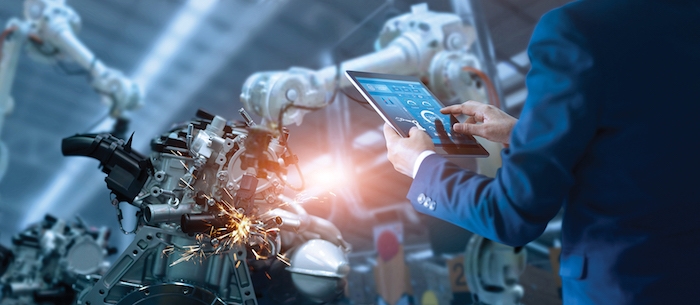
Report: Industrial robots may displace 20M manufacturing jobs by 2030
June 26, 2019
By Kristina Urquhart
 Photo: ipopba/iStock/Getty Images Plus
Photo: ipopba/iStock/Getty Images Plus June 26, 2019 – Industrial robots and automation could displace about 20 million manufacturing jobs around the world by 2030, according to a new report by Oxford Economics – but new jobs for humans will open up at nearly the same rate as they are destructed.
The authors of the “How Robots Change the World” report say those 20 million jobs amount to 8.5 per cent of the global manufacturing workforce. The loss of jobs will be felt more strongly in lower-income regions of the world, where workers tend to have lower skill levels that are more susceptible to being displaced by automation.
The study also delves into where industrial robot adoption is most prevalent. Automotive manufacturers are still among the highest adopters, using 43 per cent of the world’s share of robots in 2016, but the share of new robot installations in high-tech manufacturing grew to 31 per cent in 2016 (from 21 per cent in 2000).
The robotics dividend
While the regional impact of robot adoption varies, the study indicates that jobs are indeed being “displaced” as robotization increases – but that these robots are not necessarily eliminating permanent positions. The authors state that robots boost productivity and economic growth, creating new job opportunities at a rate comparable to that of the job displacement or destruction.
The researchers say that increase in productivity – which they call a “robotics dividend” – translates to a 0.1 per cent boost in output per worker after a one per cent increase in the stock of robots per worker in the manufacturing sector alone.
And if robotic adoption exceeds current projections by 2030, global GDP is set to grow, too. For example, if robotic adoption exceeds 30 per cent of current projections, it would result in a 5.3 per cent increase in the global GDP, which amounts to an extra $4.9 trillion added to the global economy – just for that year.
With as many industrial robots having been installed over the past four years as in the eight years previous, use in manufacturing has increased because 1) robots are cheaper to employ than humans; 2) robots are becoming more capable in sophisticated contexts; and 3) robots allow manufacturers to not only keep up with demand, but with foreign competitors, too.
The study says China now represents around one-fifth of the world’s total stock of robots, with about every third robot worldwide now being installed in China.
Protecting vulnerable jobs
The report includes a Robot Vulnerability Index, which ranks the regions of seven developed economies based on how susceptible their workforces are to the installation of industrial robots.
Regions with higher instances of traditional manufacturing tend to be the most vulnerable to automation. Canada wasn’t one of the countries profiled, but in the United States, the index rates Oregon, Louisiana, Texas, Indiana and North Carolina as most susceptible for their associations with traditional manufacturing industries such as steel, automotive, etc.
Related news
North American robot orders down 3.5% in Q1 2019
Report: Jobs at high risk of automation more likely to be held by women, says RBC
Six best practices for automation deployment
Workers that develop most of the robot innovation and knowledge – skills that are trickier to automate – tend to be located in urban centres, the report says, which is why major developed cities will fare better with job displacement over lower-income regions of the world.
The researchers indicate that as robotics adoption increases, governments will need to help workers develop new tools and skills so that they can adapt to new roles.
The study offers a framework to protect vulnerable jobs from automation, targeting stakeholders across the manufacturing sector:
- Government: Adapt policy to fit the needs of the workplace and economy during robotization; develop collaborative ecosystems for skills development, such as science parks and living labs; use labour market data and business trends to plan strategies to incentivize companies to engage in retraining programs; identify the areas most vulnerable to automation-related job displacement and make investments in infrastructure, training and welfare programmes.
- Business leaders: Look for technological solutions to keep up with innovation and global competition; communicate intentions with robots directly to workers; invest in robot training and education for your workforce.
- Educators: Focus on fostering technology skills, but also “soft” skills; develop flexible, lifelong learning opportunities that can translate to workers on the job; create new partnerships with local industry to see which skills are more or less important, and to develop specific training programs for displaced workers.
- Technology companies: Participate in industry-wide initiatives to invest in human capital, such as profit sharing; partner with government and educators on retraining and coaching; solve technological problems created by robots.
- Workers: Evaluate your own job to understand the difference between “soft” (human) skills and automatable skills, and focus on developing the human skills; understand that retraining and upskilling is normal and you will need to participate in lifelong learning; support programs that develop job flexibility, even in unionized environments.
Read the full “How Robots Change the World” report by Oxford Economics.
Advertisement
- Report: Motion control and motor market down 0.2% in Q1 2019
- Fluke Networks releases adapter for ix Industrial Ethernet connector